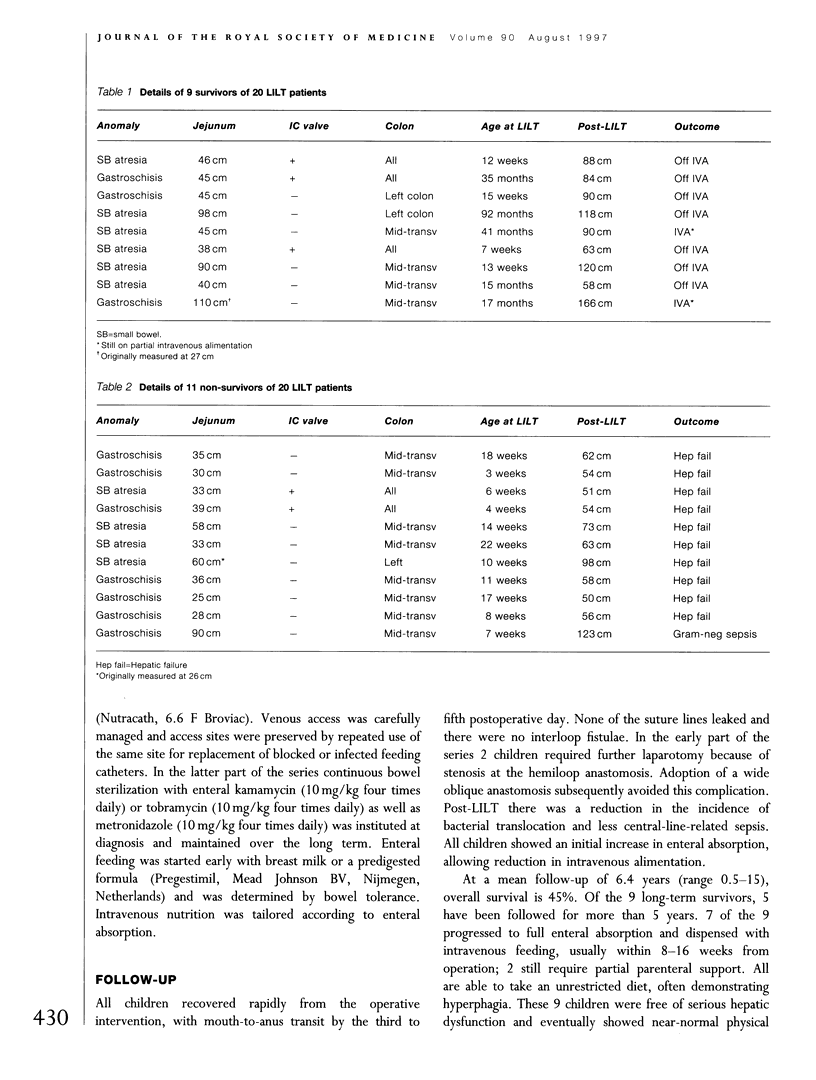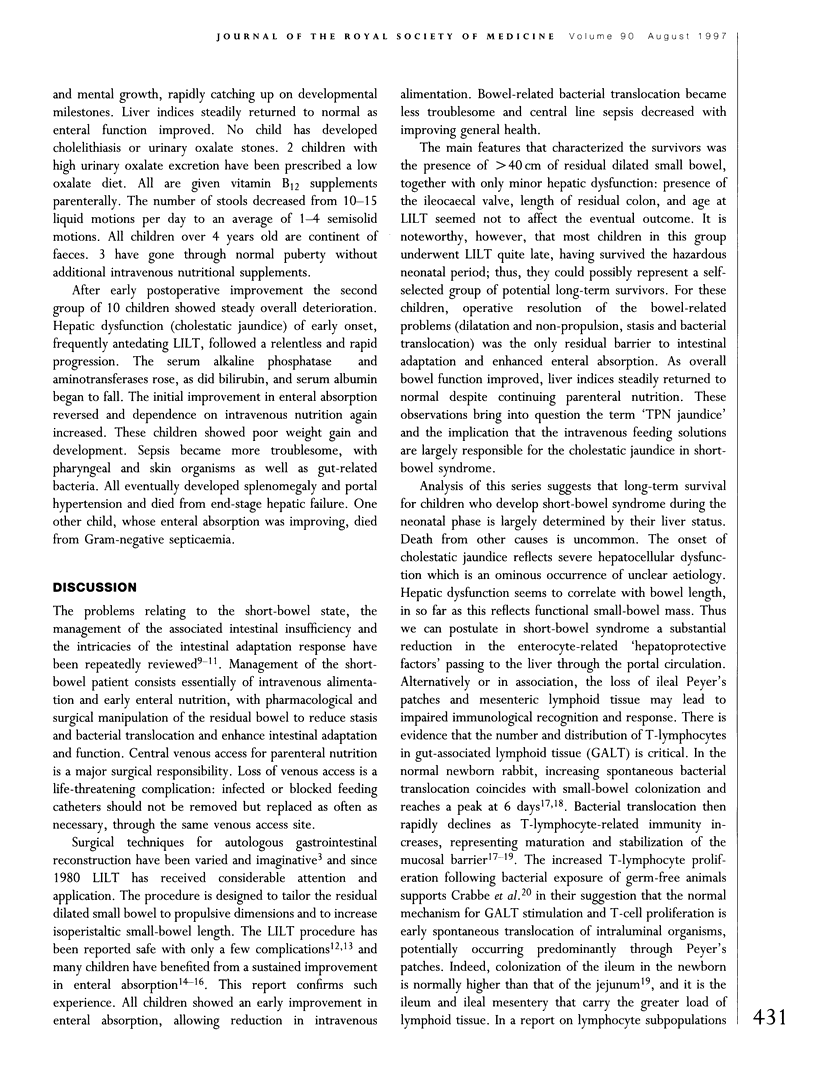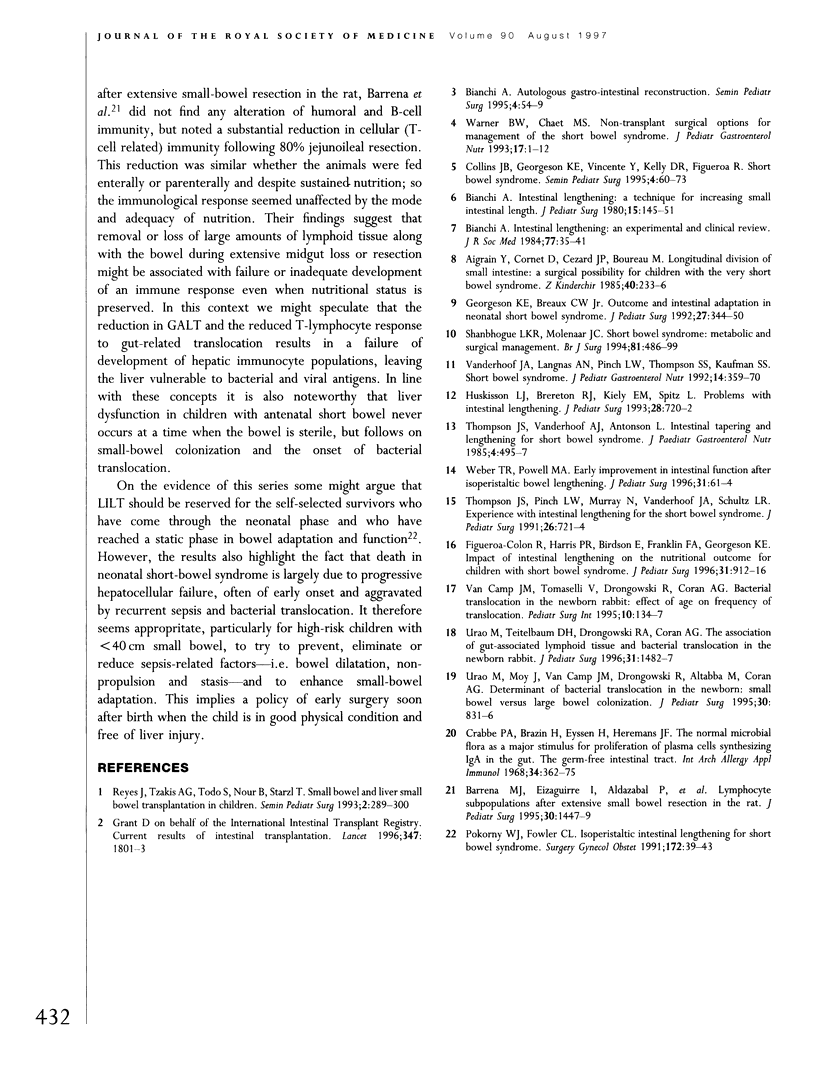Abstract
Longitudinal intestinal lengthening and tailoring (LILT) is increasingly favoured as a treatment for short-bowel syndrome. In a personal series, 20 children underwent LILT between 1962 and 1997. There was negligible morbidity (hemiloop anastomotic stenosis in 2) and no operative mortality. At a mean follow-up of 6.4 years overall survival was 45%, and certain features were clearly related to outcome. Survivors had > 40 cm of residual small bowel (commonly jejunum) and had little hepatic dysfunction despite parenteral nutrition of similar time and nature as non-survivors. Children who did not survive had < 40 cm of residual small bowel and developed early lethal hepatic dysfunction of unclear aetiology. Outcome did not seem to be influenced by the presence of the ileocaecal valve or the length of residual colon. Children born with short-bowel should be offered LILT at an early stage when still in good physical condition, so as to avoid liver-damaging intraluminal stasis and bacterial translocation and to enhance intestinal adaptation and hepatoprotective factors.
Full text
PDF



Selected References
These references are in PubMed. This may not be the complete list of references from this article.
- Aigrain Y., Cornet D., Cezard J. P., Boureau M. Longitudinal division of small intestine: a surgical possibility for children with the very short bowel syndrome. Z Kinderchir. 1985 Aug;40(4):233–236. doi: 10.1055/s-2008-1059781. [DOI] [PubMed] [Google Scholar]
- Bianchi A. Autologous gastrointestinal reconstruction. Semin Pediatr Surg. 1995 Feb;4(1):54–59. [PubMed] [Google Scholar]
- Bianchi A. Intestinal lengthening: an experimental and clinical review. J R Soc Med. 1984;77 (Suppl 3):35–41. [PMC free article] [PubMed] [Google Scholar]
- Collins J. B., Georgeson K. E., Vicente Y., Kelly D. R., Figueroa R. Short bowel syndrome. Semin Pediatr Surg. 1995 Feb;4(1):60–73. [PubMed] [Google Scholar]
- Crabbé P. A., Bazin H., Eyssen H., Heremans J. F. The normal microbial flora as a major stimulus for proliferation of plasma cells synthesizing IgA in the gut. The germ-free intestinal tract. Int Arch Allergy Appl Immunol. 1968;34(4):362–375. doi: 10.1159/000230130. [DOI] [PubMed] [Google Scholar]
- Figueroa-Colon R., Harris P. R., Birdsong E., Franklin F. A., Georgeson K. E. Impact of intestinal lengthening on the nutritional outcome for children with short bowel syndrome. J Pediatr Surg. 1996 Jul;31(7):912–916. doi: 10.1016/s0022-3468(96)90409-1. [DOI] [PubMed] [Google Scholar]
- Georgeson K. E., Breaux C. W., Jr Outcome and intestinal adaptation in neonatal short-bowel syndrome. J Pediatr Surg. 1992 Mar;27(3):344–350. doi: 10.1016/0022-3468(92)90859-6. [DOI] [PubMed] [Google Scholar]
- Huskisson L. J., Brereton R. J., Kiely E. M., Spitz L. Problems with intestinal lengthening. J Pediatr Surg. 1993 May;28(5):720–722. doi: 10.1016/0022-3468(93)90041-i. [DOI] [PubMed] [Google Scholar]
- Pokorny W. J., Fowler C. L. Isoperistaltic intestinal lengthening for short bowel syndrome. Surg Gynecol Obstet. 1991 Jan;172(1):39–43. [PubMed] [Google Scholar]
- Reyes J., Tzakis A. G., Todo S., Nour B., Starzl T. E. Small bowel and liver/small bowel transplantation in children. Semin Pediatr Surg. 1993 Nov;2(4):289–300. [PMC free article] [PubMed] [Google Scholar]
- Shanbhogue L. K., Molenaar J. C. Short bowel syndrome: metabolic and surgical management. Br J Surg. 1994 Apr;81(4):486–499. doi: 10.1002/bjs.1800810404. [DOI] [PubMed] [Google Scholar]
- Thompson J. S., Pinch L. W., Murray N., Vanderhoof J. A., Schultz L. R. Experience with intestinal lengthening for the short-bowel syndrome. J Pediatr Surg. 1991 Jun;26(6):721–724. doi: 10.1016/0022-3468(91)90019-p. [DOI] [PubMed] [Google Scholar]
- Thompson J. S., Vanderhoof J. A., Antonson D. L. Intestinal tapering and lengthening for short bowel syndrome. J Pediatr Gastroenterol Nutr. 1985 Jun;4(3):495–497. doi: 10.1097/00005176-198506000-00029. [DOI] [PubMed] [Google Scholar]
- Urao M., Moy J., Van Camp J., Drongowski R., Altabba M., Coran A. G. Determinant of bacterial translocation in the newborn: small bowel versus large bowel colonization. J Pediatr Surg. 1995 Jun;30(6):831–836. doi: 10.1016/0022-3468(95)90759-9. [DOI] [PubMed] [Google Scholar]
- Urao M., Teitelbaum D. H., Drongowski R. A., Coran A. G. The association of gut-associated lymphoid tissue and bacterial translocation in the newborn rabbit. J Pediatr Surg. 1996 Nov;31(11):1482–1487. doi: 10.1016/s0022-3468(96)90160-8. [DOI] [PubMed] [Google Scholar]
- Vanderhoof J. A., Langnas A. N., Pinch L. W., Thompson J. S., Kaufman S. S. Short bowel syndrome. J Pediatr Gastroenterol Nutr. 1992 May;14(4):359–370. doi: 10.1097/00005176-199205000-00001. [DOI] [PubMed] [Google Scholar]
- Warner B. W., Chaet M. S. Nontransplant surgical options for management of the short bowel syndrome. J Pediatr Gastroenterol Nutr. 1993 Jul;17(1):1–12. doi: 10.1097/00005176-199307000-00001. [DOI] [PubMed] [Google Scholar]
- Weber T. R., Powell M. A. Early improvement in intestinal function after isoperistaltic bowel lengthening. J Pediatr Surg. 1996 Jan;31(1):61–64. doi: 10.1016/s0022-3468(96)90320-6. [DOI] [PubMed] [Google Scholar]


